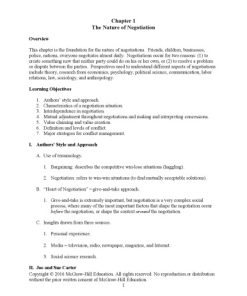Negotiation 9th Edition by Roy Lewicki 126583251X 9781265832513
$50.00 Original price was: $50.00.$25.00Current price is: $25.00.
Negotiation 9th Edition by Roy Lewicki – Ebook PDF Instant Download/DeliveryISBN: 126583251X 9781265832513
Full download Negotiation 9th Edition after payment.

Product details:
ISBN-10 : 126583251X
ISBN-13 : 9781265832513
Author : Roy Lewicki
Negotiation is a critical skill needed for effective management. Negotiation 9e by Roy J. Lewicki, David M. Saunders, and Bruce Barry explores the major concepts and theories of the psychology of bargaining and negotiation, and the dynamics of interpersonal and intergroup conflict and its resolution. It is relevant to a broad spectrum of management students, not only human resource management or industrial relations candidates.
Negotiation 9th Table of contents:
Chapter 1: The Nature of Negotiation
Introduction
A Few Words about Our Style and Approach
Joe and Sue Carter
Characteristics of a Negotiation Situation
Interdependence
Types of Interdependence Affect Outcomes
Alternatives Shape Interdependence
Mutual Adjustment
Mutual Adjustment and Concession Making
Two Dilemmas in Mutual Adjustment
Value Claiming and Value Creation
Conflict
Definitions
Levels of Conflict
Functions and Dysfunctions of Conflict
Factors That Make Conflict Easy or Difficult to Manage
Effective Conflict Management
Overview of the Chapters in This Book
Chapter Summary
Endnotes
Chapter 2: Strategy and Tactics of Distributive Bargaining
Introduction
The Distributive Bargaining Situation
The Role of Alternatives to a Negotiated Agreement
Settlement Point
Bargaining Mix
Discovering the Other Party’s Resistance Point
Influencing the Other Party’s Resistance Point
Tactical Tasks
Assess the Other Party’s Target, Resistance Point, and Costs of Terminating Negotiations
Manage the Other Party’s Impressions of Your Target, Resistance Point, and Cost of Terminating Negotiations
Modify the Other Party’s Perceptions of Their Target, Resistance Point, and Cost of Terminating Negotiations
Manipulate the Actual Costs of Delaying or Terminating Negotiations
Positions Taken during Negotiation
Opening Offers
Opening Stance
Initial Concessions
Role of Concessions
Pattern of Concession Making
Final Offers
Commitment
Tactical Considerations in Using Commitments
Preventing the Other Party from Committing Prematurely
Finding Ways to Abandon a Committed Position
Closing the Deal
Provide Alternatives
Assume the Close
Split the Difference
Exploding Offers
Sweeteners
Assessing the Quality of the Agreement
Hardball Tactics
Dealing with Typical Hardball Tactics
Typical Hardball Tactics
Distributive Bargaining Skills Applicable to Integrative Negotiations
Chapter Summary
Endnotes
Chapter 3: Strategy and Tactics of Integrative Negotiation
Introduction
An Overview of the Integrative Negotiation Process
Creating a Free Flow of Information
Attempting to Understand the Other Negotiator’s Real Needs and Objectives
Emphasizing Things in Common between the Parties and Minimizing the Differences
Searching for Solutions That Meet the Needs and Objectives of Both Sides
Key Steps in the Integrative Negotiation Process
Step 1: Identify and Define the Problem
Step 2: Surface Interests and Needs
Step 3: Generate Alternative Solutions
Step 4: Evaluate and Select Alternatives
Assessing the Quality of the Agreement
Factors That Facilitate Successful Integrative Negotiation
Some Common Objective or Goal
Faith in One’s Problem-Solving Ability
A Belief in the Validity of One’s Own Position and the Other’s Perspective
The Motivation and Commitment to Work Together
Trust
Clear and Accurate Communication
An Understanding of the Dynamics of Integrative Negotiation
Why Integrative Negotiation Is Difficult to Achieve
The History of the Relationship between the Parties
A Belief That an Issue Can Only Be Resolved Distributively
The Mixed-Motive Nature of Most Negotiating Situations
Short-Time Perspectives
Distributive Bargaining versus Integrative Negotiation
Chapter Summary
Endnotes
Chapter 4: Negotiation: Strategy and Planning
Introduction
Goals—The Focus That Drives a Negotiation Strategy
Direct Effects of Goals on Choice of Strategy
Indirect Effects of Goals on Choice of Strategy
Strategy—The Overall Plan to Achieve One’s Goals
Strategy versus Tactics
The Other Party’s Likely Strategy
The Dual Concerns Model as a Vehicle for Describing Negotiation Strategies
Understanding the Flow of Negotiations: Phases
Getting Ready to Implement the Strategy: The Planning Process
1. Defining the Negotiating Goal
2. Defining the Major Issue Related to Achieving the Goal
3. Assembling the Issues, Ranking Their Importance, and Defining the Bargaining Mix
4. Defining the Interests
5. Knowing Your Alternatives (BATNAs)
6. Knowing Your Limits, Including a Resistance Point
7. Analyzing and Understanding the Other Party’s Goals, Issues, and Resistance Points
8. Setting One’s Own Targets and Opening Bids
9. Assessing the Social Context of Negotiation
10. Presenting the Issues to the Other Party: Substance and Process
Planning the Process and Structuring the Context by which Information Is Presented
In Conclusion: Some Cautionary Notes about Planning
Chapter Summary
Endnote
Chapter 5: Ethics in Negotiation
Introduction
A Sampling of Ethical Quandaries
What Do We Mean by “Ethics,” and Why Do They Matter in Negotiation?
Ethics Defined
Applying Ethical Reasoning to Negotiation
Ethics versus Prudence versus Practicality versus Legality
Four Approaches to Ethical Reasoning
End-Result Ethics
Duty Ethics
Social Contract Ethics
Personalistic Ethics
What Questions of Ethical Conduct Arise in Negotiation?
Ethically Ambiguous Tactics: It’s (Mostly) All about the Truth
Identifying Ethically Ambiguous Tactics and Attitudes toward Their Use
Deception by Omission versus Commission
The Decision to Use Ethically Ambiguous Tactics: A Model
Why Use Deceptive Tactics? Motives and Consequences
The Power Motive
Other Motives to Behave Unethically
The Consequences of Unethical Conduct
Explanations and Justifications
What Factors Shape a Negotiator’s Predisposition to Use Unethical Tactics?
Demographic Factors
Personality Differences
Moral Development and Personal Values
Contextual Influences on Unethical Conduct
How Can Negotiators Deal with the Other Party’s Use of Deception?
Chapter Summary
Endnotes
Chapter 6: Perception, Cognition, and Emotion
Introduction
Perception
Perception Defined
Perceptual Distortion
Framing
Types of Frames
How Frames Work in Negotiation
Another Approach to Frames: Interests, Rights, and Power
The Frame of an Issue Changes as the Negotiation Evolves
Cognitive Biases in Negotiation
1. Irrational Escalation of Commitment
2. Mythical Fixed-Pie Beliefs
3. Anchoring and Adjustment
4. Issue Framing and Risk
5. Availability of Information
6. The Winner’s Curse
7. Overconfidence
8. The Law of Small Numbers
9. Self-Serving Biases
10. Endowment Effect
11. Ignoring Others’ Cognitions
12. Reactive Devaluation
Managing Misperceptions and Cognitive Biases in Negotiation
Mood, Emotion, and Negotiation
Chapter Summary
Endnotes
Chapter 7: Communication
Introduction
Basic Models of Communication
Distortion in Communication
What Is Communicated during Negotiation?
1. Offers, Counteroffers, and Motives
2. Information about Alternatives
3. Information about Outcomes
4. Social Accounts
5. Communication about Process
Are Negotiators Consistent or Adaptive?
Does It Matter What Is Said Early in the Negotiation?
Is More Information Always Better?
How People Communicate in Negotiation
Characteristics of Language
Use of Nonverbal Communication
Selection of a Communication Channel
How to Improve Communication in Negotiation
The Use of Questions
Listening
Role Reversal
Chapter Summary
Endnotes
Chapter 8: Finding and Using Negotiation Power
Introduction
Why Is Power Important to Negotiators?
A Definition of Power
Sources of Power—How People Acquire Power
Informational Sources of Power
Power Based on Personality and Individual Differences
Power Based on Position in an Organization (Structural Power)
Power Based on Relationships
Social Capital
Contextual Sources of Power
The Consequences of Unequal Power
Dealing with Others Who Have More Power
Chapter Summary
Endnotes
Chapter 9: Influence
Introduction
Two Routes to Influence: An Organizing Model
The Central Route to Influence: The Message and Its Delivery
Message Content
Message Structure
Persuasive Style: How to Pitch the Message
Peripheral Routes to Influence
Aspects of Messages That Foster Peripheral Influence
Source Characteristics That Foster Peripheral Influence
Aspects of Context That Foster Peripheral Influence
The Role of Receivers—Targets of Influence
Understanding the Other’s Perspective
Resisting the Other’s Influence
Chapter Summary
Endnotes
Chapter 10: Relationships in Negotiation
Introduction
Why Past Research on Dyadic Negotiation Needs to Be Re-evaluated for Relationships
Forms of Relationships
Four Fundamental Relationship Forms
Key Elements in Managing Negotiations within Relationships
Reputation
Trust
Justice
Relationships among Reputation, Trust, and Justice
Repairing a Relationship
Chapter Summary
Endnotes
Chapter 11: Agents, Constituencies, and Audiences
Introduction
The Number of Parties in a Negotiation
How Agents, Constituents, and Audiences Change Negotiations
Audiences: Team Members, Constituents, Bystanders, and Others
Tactical Implications of Social Structure Dynamics: The Negotiator’s Dilemma
Advice to Agents on Managing Constituencies and Audiences
Clarify the Role Expectations and Performance Contract
Clarify Authority to Make Agreements
Manage Constituency Visibility and Communication
Communicate Indirectly with Audiences and Constituents
Communicate Directly to the Other Party’s Constituency
Communicate Directly to Bystanders
Build Relationships with Audiences, Constituents, and Other Agents
When to Use an Agent
Managing Agents
Chapter Summary
Endnotes
Chapter 12: Coalitions
Introduction
A Situation with More Than Two Parties
What Is a Coalition?
Types of Coalitions
How and Why Coalitions Form and Develop
When Do Coalitions Form?
How Do Coalitions Develop?
Standards for Coalition Decision Making
Power and Leverage in Coalitions
How to Build Coalitions: Some Practical Advice
Chapter Summary
Endnotes
Chapter 13: Multiple Parties, Groups, and Teams in Negotiation
Introduction
The Nature of Multiparty Negotiations
Differences between Two-Party Negotiations and Various Forms of Multiparty Negotiations
What Group Dynamics Can Make a Multiparty Negotiation Effective?
Managing Multiparty Negotiations
The Prenegotiation Stage
The Formal Negotiation Stage—Managing the Group Process and Outcome
The Agreement Stage
Intergroup Negotiations
Chapter Summary
Endnotes
Chapter 14: Individual Differences I: Gender and Negotiation
Introduction
Defining Sex and Gender
Research on Gender Differences in Negotiation
Theoretical Perspectives on Negotiator Gender
Empirical Findings on Gender Differences in Negotiation
Overcoming Gender Differences
Motivational Interventions
Cognitive Interventions
Situational Interventions
Do Gender Differences Really Exist?
Chapter Summary
Endnotes
Chapter 15: Individual Differences II: Personality and Abilities
Introduction
Personality and Negotiation
Conflict Style
Social Value Orientation
Interpersonal Trust
Self-Efficacy and Locus of Control
Self-Monitoring
Machiavellianism
Face Threat Sensitivity
Epistemic Motivation
The “Big Five” Personality Factors
Abilities in Negotiation
Cognitive Ability
Emotional Intelligence
Perspective-Taking Ability
Cultural Ability
An Alternative Approach: Studying Experienced Negotiators
A Concluding Note
Chapter Summary
Endnotes
Chapter 16: International and Cross-Cultural Negotiation
Introduction
International Negotiation: Art and Science
What Makes International Negotiation Different?
Environmental Context
Political and Legal Pluralism
International Economics
Foreign Governments and Bureaucracies
Instability
Ideology
Culture
External Stakeholders
Immediate Context
Relative Bargaining Power
Levels of Conflict
Relationship between Negotiators
Desired Outcomes
Immediate Stakeholders
Five Conceptualizations of Culture and Negotiation
Culture as Shared Values
Hofstede’s Model of Cultural Dimensions
Hall’s Model of Cultural Values
Section Summary
Cultural Syndromes and Logics
Cultural Tightness-Looseness
Culture as Learned Behavior
Culture in Context
The Influence of Culture on Negotiation: Managerial Perspectives
Definition of Negotiation
Negotiation Opportunity
Selection of Negotiators
Protocol
Communication
Time Sensitivity
Risk Propensity
Groups versus Individuals
Nature of Agreements
Emotionalism
The Influence of Culture on Negotiation: Research Perspectives
Effects of Culture on Negotiation Outcomes
Effects of Culture on Negotiation Process and Information Exchange
Effects of Culture on Negotiator Cognition
Effects of Culture on Negotiator Ethics and Tactics
Effects of Culture on Conflict Resolution
Culturally Responsive Negotiation Strategies
Weiss’s Culturally Responsive Strategies
Low Familiarity
Moderate Familiarity
High Familiarity
Chapter Summary
Endnotes
Chapter 17: Managing Negotiation Impasses
Introduction
The Nature of Difficult-to-Resolve Negotiations and Why They Occur
The Nature of Impasse
What Causes Impasses and Intractable Negotiations?
Characteristics of the Issues
Characteristics of the Parties
Characteristics of the Negotiation Environment
Characteristics of the Negotiation Setting
Fundamental Mistakes That Cause Impasses
Preventing Impasses
How to Resolve Impasses
Agreement on the Rules and Procedures
Reducing Tension and Synchronizing De-escalation
Improving the Accuracy of Communication
Controlling Issues
Establishing Common Ground
Enhancing the Desirability of Options to the Other Party
Chapter Summary
Endnotes
Chapter 18: Managing Difficult Negotiations
Introduction
Managing the Shadow Negotiation and Social Contract
Power Moves
Process Moves
Appreciative Moves
Responding to the Other Side’s Hard Distributive Tactics
Call Them on It
Ignore Them
Respond in Kind
Offer to Change to More Productive Methods
Responding to Irrationality
Responding When the Other Side Has More Power
The Special Problem of Handling Ultimatums
Responding to Anger
Responding When the Other Side Is Being Difficult
Ury’s Breakthrough Approach
Responding to Difficult People
Having Conversations with Difficult People
Preparation
Managing Difficult Conversations
Duplicitous Negotiations
Chapter Summary
Endnotes
Chapter 19: Third-Party Approaches to Managing Difficult Negotiations
Introduction
Adding Third Parties to the Two-Party Negotiation Process
Benefits and Liabilities of Third-Party Intervention
When Is Third-Party Involvement Appropriate?
Which Type of Intervention Is Appropriate?
Types of Third-Party Intervention
Formal Intervention Methods
Arbitration
Mediation
Process Consultation
Combining Formal Intervention Methods
Informal Intervention Methods
Which Approach Is More Effective?
Alternative Dispute Resolution Systems
Chapter Summary
Endnotes
Chapter 20: Best Practices in Negotiations
Introduction
1. Be Prepared
2. Diagnose the Fundamental Structure of the Negotiation
3. Identify and Work the BATNA
4. Be Willing to Walk Away
5. Master the Key Paradoxes of Negotiation
Claiming Value versus Creating Value
Sticking by Your Principles versus Being Resilient Enough to Go with the Flow
Sticking with Your Strategy versus Opportunistically Pursuing New Options
Being Too Honest and Open versus Being Too Closed and Opaque
Being Too Trusting versus Being Too Distrusting
6. Remember the Intangibles
7. Actively Manage Coalitions—Those against You, for You, and Unknown
8. Savor and Protect Your Reputation
9. Remember That Rationality and Fairness Are Relative
10. Continue to Learn from Your Experience
People also search for Negotiation 9th:
the art of negotiation
salary negotiation email
batna negotiation
define negotiation
zopa negotiation
Tags:
Negotiation,Roy Lewicki,
You may also like…
Business & Economics - Management & Leadership
Mediation : Negotiation by Other Moves 1st Edition Alain Lempereur 9781119805359 111980535X
Business & Economics - Management & Leadership
Uncategorized
Business & Economics - Management & Leadership
Business & Economics - Management & Leadership
Business & Economics - Management & Leadership
Business & Economics - Management & Leadership












